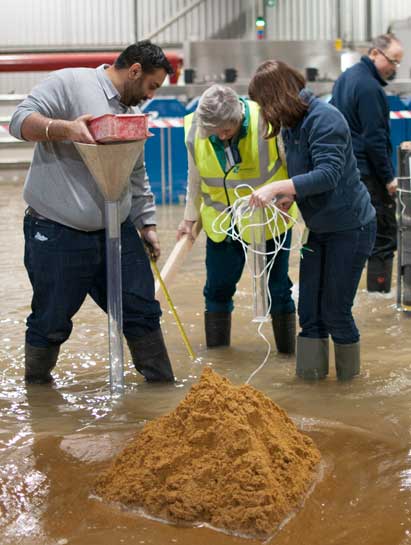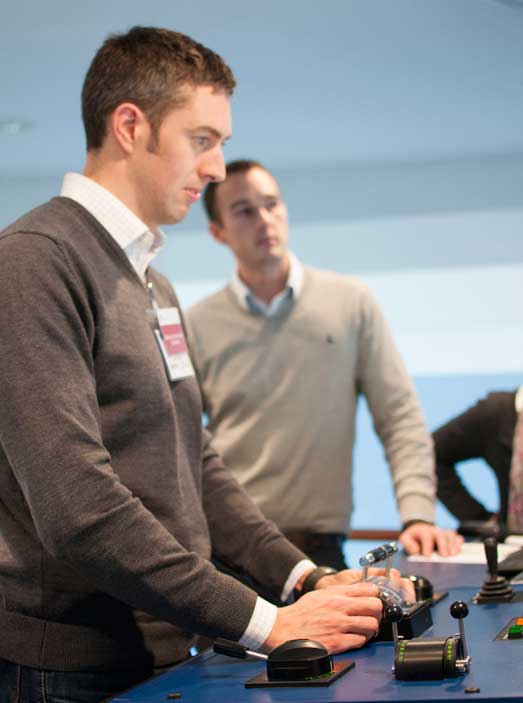








Philippa and her company, Open Limits, were recommended to me because of their innovative approach to team development through the use of simulation exercises. I'm so glad I listened to the recommendation because not only are Philippa and Nigel very easy to work with, and very capable, but their Apollo 13 simulation exercise has been very well received by the 60+ people in the department. The simulation gets people talking about processes and information sharing and cross team communication skills, but Philippa brings it all to life to provide, as one of my team put it, "the best course ever".

The consultancy organisation Open Limits is pleased to announce its UK launch of a brand new business simulation ‘The Phoenix Project’, on 15th June 2016 at BCS, The Chartered Institute for IT, London offices, located near Covent Garden
The simulation is based on the best-selling book called ‘The Phoenix Project’ that has inspired many thousands of business leaders to implement digital business transformations in their organisations. The project on the day is played in four rounds whereby attendees are given roles which include IT Support, IT Development, CIO, QA, Security, CFO, Retail Operations and Head of HR.
Participants at the event will take a role, and share in the decision making, change planning and implementation, in a continually evolving, complex, political business environment, with stakeholders with varying degrees of understanding of – and buy-in to – digital transformation.
Open Limits are inviting senior managers from across IT, as well as from different business functions, plus a number of industry specialists and experienced DevOps practitioners. Jan Schilt, the Simulation designer, will be coming over from the Netherlands to facilitate at the event, and the day will be introduced by Jon Buttriss CEO of BCS Learning & Development Ltd, part of the Institute.
Jon Buttriss, CEO of BCS L&D Ltd, part of BCS, The Chartered Institute for IT, said,
"The role of simulation projects is vital in terms of providing organisations with innovative business solutions. Organisations which adopt the right DevOps methodology and agile processes can ensure they have a successful edge over competitors in the digital age.”
Open Limits are a consultancy and learning organisation who help develop enterprise-savvy technical specialists and digital-savvy organisation leaders. It explores together how to bring in lean agile work flows and real collaboration within the IT function and across the business.
For more information on Open Limits visit: www.openlimits.com

Looking for something challenging for a memorable and productive senior team event? We have just launched a new business simulation, designed in collaboration with HR (Hydraulics Research) Wallingford and using their world class facilities. The team challenge: to lead the project to build a state-of-the-art 200 turbine offshore windfarm, and handle high levels of technical and business complexity, multiple environmental risks and challenges.

The combination of the Open Limits proven approach to team facilitation and project leadership development and HR Wallingford’s extraordinary facilities has created a real winning formula. A group of senior executives and seasoned project leaders from many different organisations and sectors helped us to pilot the event. We were keen to ensure that the activities were authentic and stimulating, and the learning opportunities sufficiently rich and relevant to today’s leadership and project team challenges. Below are some of the learning points shared by the group, with many thanks to all for allowing us to share this knowledge.

‘A huge amount of information to take away that is relevant to my role and I can use’
(Tony Appleton - Business Development Director, Parsons Brinckerhoff)
‘An excellent opportunity to develop leadership skills. One day was not enough!’
(Nick Podevyn - Senior Project Manager, Res-Offshore)
‘Impressive, and great fun!’
(Neil Wimbledon - Head of Projects & Strategic Systems, British Gas)
‘The Ship Simulator was amazing and really brought the project leadership principles to life’
(Rachel Pedrick - Met Ocean Manager, UTEK Geomarine Ltd)
‘The facilitators helped us to realise the wealth of experience in the room and how to tap into it’
(Vic Gabrie - Consulting Manager, Oracle)
‘I found the simulation interesting, challenging and fun!’ It is always a challenge making engineers/scientists take on board ‘soft skills’ as we are too used to analysing data and being professional sceptics!’
(Chris Lomax - Technical Director, Head of Ports & Marine, Parsons Brinckerhoff)

The UK is currently the world's biggest offshore wind market due to the relatively strong winds and shallow waters around the UK coastline. The UK government is keen to meet the European Union target of 15% of final energy consumption from renewable sources by 2020 and is focusing on off-shore wind.
You will be a part of a multidisciplinary team of technical specialists, contractors and business leaders. You will be required to complete a feasibility study to lay the cables on the sea bed to connect the 200 turbines, and then to take the installation crew out to the turbines for commissioning. In itself this is a multi-£million project. You will need to scope the full Windfarm programme and influence decision making by engaging with all internal stakeholders, plus government agencies and environmental groups. If you meet the project deadline you will secure the EU green energy subsidy for the whole programme. The company’s 5-star safety rating must be maintained however, so speed and safety are paramount.
To achieve the mission you will need to demonstrate:
You will receive valuable feedback from the facilitators and from fellow participants after each round of the simulation. Elements of the event will be videoed as an additional learning opportunity, and facilitators will provide a full summary of learning points and recommendations, relating to the objectives set by the group.
For more information on these simulations contact Nigel Hale on 07737819225, +44 (0)1202 473782, nigel.hale@openlimits.com

We have just become a 'Silver Status' Partner to GamingWorks, so we are now the largest distributor of GamingWorks' excellent business simulations in the UK, and part of the GamingWorks global network.
Our 'best seller' remains the Apollo 13 mission – a challenging, enjoyable and memorable demonstration of business processes and the considerable value they can add to team cohesion and organisational effectiveness. Teams explore together how to improve business services and cross-team collaboration, as their organisation evolves, bringing in new processes, without killing creativity and responsiveness. Or the Astronauts!
The Apollo 13 mission can also be run as a highly motivating and engaging exploration of how to run a slick and well respected IT Service Management department. IT Service Management teams can consolidate their knowledge of ITSM/ITIL and understand how to make it work in their real world, with 'right-sized' processes and excellent cross team collaboration.
"I would whole heartedly recommend Open Limits to any organisation going through change, or wishing to embrace change more readily. I have worked with them on a number of occasions, most notably as part of a leadership team, where they provided training and mentoring. I found their manner refreshingly open, and their approach flexible. Open Limits helped me build a new management team, understood what I wanted to achieve with the team, and facilitated an amazing get together which flexed with the personalities involved and stimulated excellent debate. The energy within the team changed immediately and for the good, and for once all of the actions which came out of the meeting actually got done. They helped make sure these actions were real and specific, not "Motherhood and Apple Pie!!!"
Open Limits just get it..."

Director & Senior Consultant

Core Team

Core Team

Core Team

Core Team

Core Team
"I could have ticked every box to describe Philippa and her training company Open Limits!
I have worked very closely with Philippa in creating a comprehensive Leadership Development programme for 2 management levels across four modules. This was a global programme across 24 countries and Philippa quickly and clearly understood our culture, style, needs and tone of how to roll out this programme. I find Philippa to be inspirational, easy to work with, a true expert in her field and best all, she just gets it!
I believe we will continue to have a long working relationship with Open Limits - especially when we can now demonstrate tangible results as measurable outcomes."

We are an established provider to the BCS and have co-designed and delivered Management & Leadership Development programmes and Team Coaching programmes for BCS clients: IT departments of large organisations across all sectors, private, public and charitable.

We are proud to be a part of this global community of organisations including Open Limits who use these simulations for powerful organisation and team development. GamingWorks' simulations focus on IT Service Management, IT/Business Alignment, Logistics, Cyber Security, Business Processes, Project and Programme Management and Organisational Change.

CLS provides tailor-made training solutions, specialising in business skills, management and leadership development, and executive coaching for Clients including Vodafone, ACE and SunGard.
Open Limits Ltd
Arena Business Centre, 9 Nimrod way, Ferndown, Dorset, BH21 7UH
+44 (0)1202 473782
info@openlimits.com